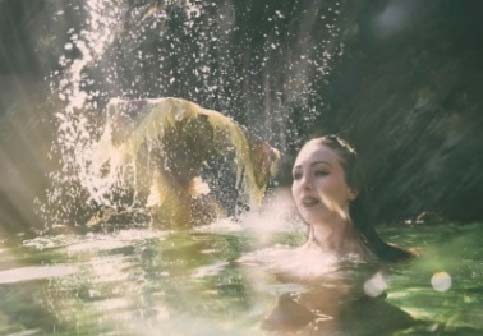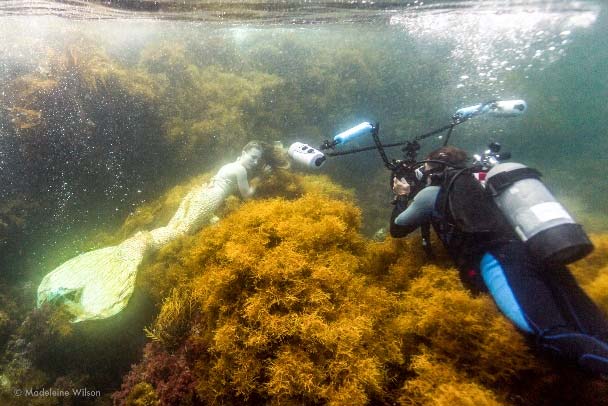Santa Barbara Maritime Museum Presents Mermaids: Visualizing the Myths & Legends – Photography by Ralph A. Clevenger & Friends
Santa Barbara, CA. October 1, 2021 – The Santa Barbara Maritime Museum is pleased to announce the long-awaited re-opening of the exhibit, Mermaids: Visualizing the Myths & Legends – Photography by Ralph A. Clevenger & Friends, 16 images printed on canvas by Ralph Clevenger and friends. Originally scheduled to open on April 22, 2020, the exhibit was postponed because of the Covid-19 pandemic closures. Now, thanks to the generous support of George H. & Olive J. Griffiths Charitable Foundation, Mimi Michaelis, John C. Mithun Foundation, June G, Outhwaite Charitable Trust, Alice Tweed Tuohy Foundation, and the Wood-Claeyssens Foundation, the exhibit will be open to the public from November 11, 2021, through March 31, 2022. There will also be mermaid photo opportunities at the museum by appointment on Saturday, November 13, 2021, from 11:30am-12:30pm and 1-2pm, $10 for museum members and $30 for non-members.
How this exhibit came to be

Most of the 16 images displayed in the Santa Barbara Maritime Museum’s gallery exhibit – Mermaids: Visualizing the Myths & Legends—were part of an underwater photography course Ralph Clevenger taught at Brooks Institute. Each summer students in the class would spend several days living on a dive boat off the Channel Islands where they would work on their assignments. He would invite professional mermaids to join the class on the boat and work with the students, creating portraits, visual stories, and conceptual images for their final class portfolios.
A hard day’s work for a mermaid
In Ralph’s own words, as the students worked, the models faced a number of difficulties: “There is no question about how hard the mermaids worked for these images. Wearing cloth-covered monofin tails or silicone molded tails they could swim farther and faster than any of us. While students wore wetsuits in the cool 70° water, the mermaids were nearly naked, spending upwards of thirty minutes in the water at a time during a photo shoot.” Further, Clevenger said, “The models had to hold their breath and repeatedly dive down, release their breath, so their face looked natural, pose gracefully, then return to the surface. They did this over and over, all day long. We always provided safety divers, paddle boards for the mermaids to rest on, and hot showers and warm drinks on the boat in between shoots.”
Mermaids: The origins of the myth
Thousands of years ago, the Assyrian goddess of the sea, Atargatis, transformed herself into a mermaid by flinging herself into a lake. She emerged with the lower body of a fish and the upper body of a human. Ever since, mermaids and mermen have captivated the imaginations of people and cultures around the world, including Europe, Asia, and Africa. In the West, the idea of mermaids may have been influenced by the sirens in Greek Mythology. A popular subject of art and literature, they have also been the subject of operas, comics, animation, and live action films.
Ralph A. Clevenger grew up on the coast of North Africa and began diving with his father in the Mediterranean Sea at the age of 7. He went on to study zoology and worked for the Scripps Institution of Oceanography in San Diego as a diver/biologist before attending Brooks Institute of Photography. Clevenger was a senior faculty member at the Brooks Institute for 33 years, teaching courses in Natural History and Underwater Photography, among other photo and video courses.

Based in Santa Barbara, California, Mr. Clevenger is continuing to pursue his passion for the natural world by specializing in location photography and video projects of eco-travel, environmental portraits, wildlife, and undersea subjects. He’s traveled on assignment for clients such as Fox Sports, University of California, Denali National Park Wilderness Center, National Marine Sanctuaries, Light & Motion Industries, and others. His publication credits include Audubon, Afar, Islands, Oceans, Nature’s Best, National Geographic, Terre Sauvage, and other national and international publications. He is the author of the book Photographing Nature, published by New Riders.
~ ~ ~
Since 2000, the Santa Barbara Maritime Museum has featured many artifacts and stories to share the history of the Santa Barbara Channel with more than 40,000 visitors annually and provides year-round experiential maritime history and marine science education for local youth. Featuring the impressive First-Order Fresnel Lighthouse Lens from Point Conception, SBMM’s exhibits include History of Oil in Santa Barbara Channel, the Honda Disaster, and Wives and Daughters: Keepers of the Light.
